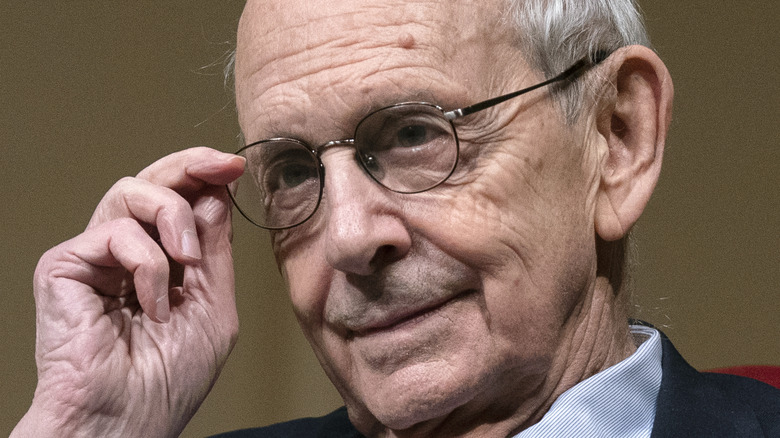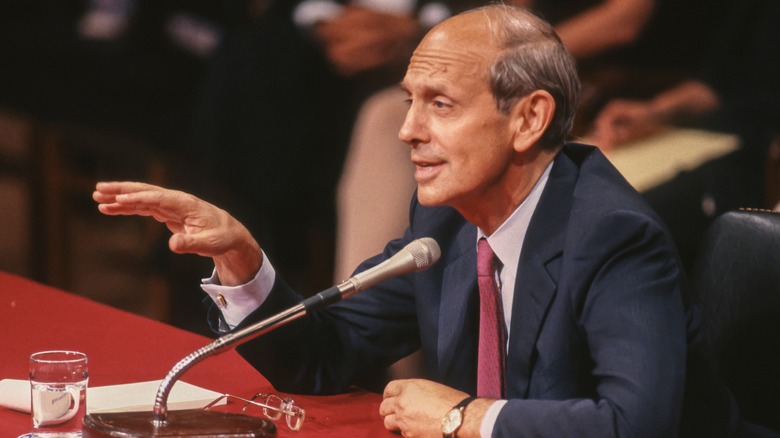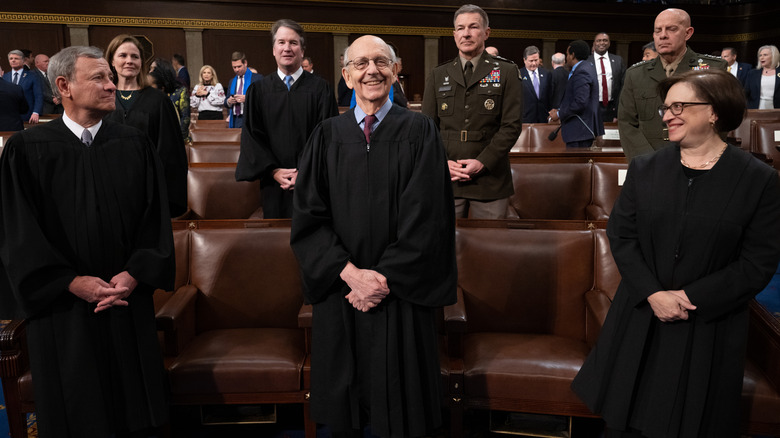Justice Stephen Breyer Was Born With Politics In His Blood
Recent, contentious U.S. Supreme Court decisions, like the overturning of 1973's Roe v. Wade, have driven home an abundantly salient point to American citizens: Supreme Court justices need to be very, very carefully chosen. This is a monumental task, made no less difficult because no citizen besides the president nominates a justice, and especially because the position lasts for life. The intention may be, as the White House website says, to keep justices "insulated from political pressures." At worst, though, such insulation runs the risk of barricading justices from the very real needs of everyday people.
So how did Justice Stephen Breyer do it? Breyer, who has held his position since 1994 and is set to retire on June 30, 2022, has cultivated a widely respected and admired reputation on both sides of the political aisle. As The Washington Post puts it, he's characterized as a "pragmatist" and "problem-solver" interested in upholding the Supreme Court's legacy. He's called a "centrist," though he's been a staunch supporter of abortion rights (yes, Breyer voted to uphold Roe v. Wade, via NBC Chicago), environmental care, and health-care coverage. But most tellingly, he's always stayed focused on "real-world implications" of the court's decision.
A huge portion of Breyer's success boils down to his character. He's a brilliant, charismatic rhetorician and speaker, as even only one single interview with the Harvard Kennedy School illustrates (on YouTube). Hearing him speak, it sounds like Breyer was born for politics. And in a sense, he was.
Born into politics and the law
Born in 1938 in San Francisco, Stephen Breyer was raised neck-deep in political activism and the law. As Biography relates, his father was an attorney for the San Francisco Board of Education, while his mother was a volunteer with the League of Women Voters, a voter's rights organization that exists to this day. (Remember that women in the U.S. had only gotten the right to vote in 1920 with the 19th Amendment, less than 20 years before Breyer's birth, via the U.S. National Archives). As U.S. News & World Report says, even Breyer's younger brother Charles became a defense attorney. Charles was given a federal judge appointment by President Clinton in 1997, three years after Breyer got his own Supreme Court appointment.
All in all, it looks like Justice Breyer's path was all but laid out the moment he was born. He received from his parents strong notions of "public service," and was by all accounts gifted with a powerful mind. He was the "troop brain" in Eagle Scouts, and a member of his high school debate team, where he was voted "most likely to succeed." Breyer's debate coach stated, "You can spot the potential lawyers early ... He would do copious research on a debate topic while other kids were out, you know, doing things like stealing hubcaps." Breyer went on to study philosophy at Stanford University in 1955, and then philosophy and economics at Oxford University before enrolling at Harvard Law School. He graduated in 1964.
Fated for the Supreme Court
Oyez goes into detail about the unwavering direction of Justice Breyer's career. Breyer went to work for Supreme Court Justice Arthur Goldberg directly out of Harvard, a move that foreshadowed Breyer's later appointment to the same position come 1994, four years after Justice Goldberg died. Goldberg, it should be noted, was a legendary figure in recent U.S. legal history who helped veer the Supreme Court towards broader civil rights inclusion during a critical phase of U.S history during the 1960s, as Oyez also explains. Breyer would pick up this torch, as well.
After leaving his position with Justice Goldberg, Breyer worked for the U.S. Attorney General before going back to his alma mater, Harvard. He began teaching at Harvard Law in 1967, and through the '90s continued going back and forth between academics and government, maintaining his teaching position in some capacity while also working on numerous governmental committees, including a role as Assistant Special Prosecutor in 1973 during President Nixon's Watergate scandal. Come 1994, CNN reports that President Clinton didn't immediately take to Breyer as Supreme Court Justice, but in the end, Hilary Clinton steered her husband to the choice because the president's top pick, Judge Richard Arnold, wasn't in good health. Arnold died in 2004.
In the end, Justice Breyer could have pursued a career as a graffiti artist, stunt coordinator, kindergarten teacher, or any number of things. However, it seems like his blood and stars had a different fate in mind.


